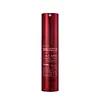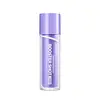What's inside
What's inside
 Key Ingredients
Key Ingredients

 Benefits
Benefits

 Concerns
Concerns

 Ingredients Side-by-side
Ingredients Side-by-side

Water
Skin ConditioningGlycerin
HumectantButylene Glycol
HumectantDipropylene Glycol
HumectantNiacinamide
SmoothingPropanediol
SolventDiethoxyethyl Succinate
Solvent1,2-Hexanediol
Skin ConditioningSodium Carbomer
Emulsion StabilisingC12-14 Alketh-12
EmulsifyingSilica
AbrasiveEclipta Prostrata Extract
Skin ConditioningAmmonium Acryloyldimethyltaurate/Vp Copolymer
Dextrin
AbsorbentTheobroma Cacao Extract
Skin ConditioningCroton Zambesicus Powder
Hydroxyacetophenone
AntioxidantXanthan Gum
EmulsifyingAmmonium Polyacryloyldimethyl Taurate
Emulsion StabilisingMelia Azadirachta Leaf Extract
Skin ConditioningCaprylyl Glycol
EmollientEthylhexylglycerin
Skin ConditioningAdenosine
Skin ConditioningTromethamine
BufferingTetrahydroxypropyl Ethylenediamine
Disodium EDTA
Malachite Extract
AntioxidantMoringa Oleifera Seed Oil
EmollientCentella Asiatica Extract
CleansingT-Butyl Alcohol
PerfumingPanthenol
Skin ConditioningArbutin
AntioxidantArginine
MaskingGlycine
BufferingTocopherol
AntioxidantHexylresorcinol
AntimicrobialHydrogenated Lecithin
EmulsifyingSodium Hyaluronate
HumectantCeramide NP
Skin ConditioningPropolis Extract
Skin ConditioningAsiaticoside
AntioxidantGlycosphingolipids
EmollientMadecassic Acid
Skin ConditioningMadecassoside
AntioxidantAsiatic Acid
Skin ConditioningWater, Glycerin, Butylene Glycol, Dipropylene Glycol, Niacinamide, Propanediol, Diethoxyethyl Succinate, 1,2-Hexanediol, Sodium Carbomer, C12-14 Alketh-12, Silica, Eclipta Prostrata Extract, Ammonium Acryloyldimethyltaurate/Vp Copolymer, Dextrin, Theobroma Cacao Extract, Croton Zambesicus Powder, Hydroxyacetophenone, Xanthan Gum, Ammonium Polyacryloyldimethyl Taurate, Melia Azadirachta Leaf Extract, Caprylyl Glycol, Ethylhexylglycerin, Adenosine, Tromethamine, Tetrahydroxypropyl Ethylenediamine, Disodium EDTA, Malachite Extract, Moringa Oleifera Seed Oil, Centella Asiatica Extract, T-Butyl Alcohol, Panthenol, Arbutin, Arginine, Glycine, Tocopherol, Hexylresorcinol, Hydrogenated Lecithin, Sodium Hyaluronate, Ceramide NP, Propolis Extract, Asiaticoside, Glycosphingolipids, Madecassic Acid, Madecassoside, Asiatic Acid
Water
Skin ConditioningDipropylene Glycol
HumectantGlycerin
HumectantGlycereth-26
HumectantNiacinamide
SmoothingOlea Europaea Fruit Oil
MaskingEthylhexyl Palmitate
EmollientAllium Cepa Bulb Extract
Skin ConditioningButylene Glycol
HumectantSorbitan Sesquioleate
EmulsifyingPropanediol
SolventSodium Acrylate/Sodium Acryloyldimethyl Taurate Copolymer
Emulsion StabilisingCetearyl Olivate
Hydroxyacetophenone
AntioxidantVinyldimethicone
Polyisobutene
Acrylates/C10-30 Alkyl Acrylate Crosspolymer
Emulsion StabilisingSorbitan Olivate
EmulsifyingHydrolyzed Sponge
Skin ConditioningTromethamine
BufferingSodium Polyacrylate
AbsorbentEthylhexylglycerin
Skin ConditioningAdenosine
Skin ConditioningCaprylyl/Capryl Glucoside
CleansingSorbitan Oleate
EmulsifyingZea Mays Kernel Extract
Disodium EDTA
Sodium Hyaluronate
HumectantHyaluronic Acid
HumectantHydrolyzed Hyaluronic Acid
HumectantPortulaca Oleracea Extract
Skin ConditioningFructan
Skin ConditioningGlucose
HumectantPentylene Glycol
Skin ConditioningHydrolyzed Collagen
EmollientPanthenol
Skin ConditioningMadecassoside
AntioxidantDecyl Glucoside
CleansingPolyglyceryl-10 Laurate
Skin ConditioningCaprylyl Glycol
EmollientPhosphatidylcholine
EmulsifyingEctoin
Skin ConditioningCeramide NP
Skin ConditioningResveratrol
AntioxidantAllantoin
Skin ConditioningBeta-Sitosterol
Emulsion StabilisingWater, Dipropylene Glycol, Glycerin, Glycereth-26, Niacinamide, Olea Europaea Fruit Oil, Ethylhexyl Palmitate, Allium Cepa Bulb Extract, Butylene Glycol, Sorbitan Sesquioleate, Propanediol, Sodium Acrylate/Sodium Acryloyldimethyl Taurate Copolymer, Cetearyl Olivate, Hydroxyacetophenone, Vinyldimethicone, Polyisobutene, Acrylates/C10-30 Alkyl Acrylate Crosspolymer, Sorbitan Olivate, Hydrolyzed Sponge, Tromethamine, Sodium Polyacrylate, Ethylhexylglycerin, Adenosine, Caprylyl/Capryl Glucoside, Sorbitan Oleate, Zea Mays Kernel Extract, Disodium EDTA, Sodium Hyaluronate, Hyaluronic Acid, Hydrolyzed Hyaluronic Acid, Portulaca Oleracea Extract, Fructan, Glucose, Pentylene Glycol, Hydrolyzed Collagen, Panthenol, Madecassoside, Decyl Glucoside, Polyglyceryl-10 Laurate, Caprylyl Glycol, Phosphatidylcholine, Ectoin, Ceramide NP, Resveratrol, Allantoin, Beta-Sitosterol
 Reviews
Reviews

Ingredients Explained
These ingredients are found in both products.
Ingredients higher up in an ingredient list are typically present in a larger amount.
Adenosine is in every living organism. It is one of four components in nucleic acids that helps store our DNA.
Adenosine has many benefits when used. These benefits include hydrating the skin, smoothing skin, and reducing wrinkles. Once applied, adenosine increases collagen production. It also helps with improving firmness and tissue repair.
Studies have found adenosine may also help with wound healing.
In skincare products, Adenosine is usually derived from yeast.
Learn more about AdenosineButylene Glycol (or BG) is used within cosmetic products for a few different reasons:
Overall, Butylene Glycol is a safe and well-rounded ingredient that works well with other ingredients.
Though this ingredient works well with most skin types, some people with sensitive skin may experience a reaction such as allergic rashes, closed comedones, or itchiness.
Learn more about Butylene GlycolCaprylyl Glycol is a humectant and emollient, meaning it attracts and preserves moisture.
It is a common ingredient in many products, especially those designed to hydrate skin. The primary benefits are retaining moisture, skin softening, and promoting a healthy skin barrier.
Though Caprylyl Glycol is an alcohol derived from fatty acids, it is not the kind that can dry out skin.
This ingredient is also used as a preservative to extend the life of products. It has slight antimicrobial properties.
Learn more about Caprylyl GlycolCeramide NP is a type of ceramide and formally known as ceramide 3.
Ceramides are intercellular lipids naturally found in our skin that bonds dead skin cells together to create a barrier. They are known for their ability to hold water and thus are a great ingredient for dry skin.
Ceramides are an important building block for our skin barrier. A stronger barrier helps the skin look more firm and hydrated. By bolstering the skin ceramides act as a barrier against irritating ingredients. This can help with inflammation as well.
If you would like to eat ceramides, sweet potatoes contain a small amount.
Read more about other common types of ceramides here:
Ceramide AP
Ceramide EOP
Dipropylene Glycol is a synthetically created humectant, stabilizer, and solvent.
This ingredient helps:
Dipropylene glycol is technically an alcohol, but it belongs to the glycol family (often considered part of the ‘good’ alcohols). This means it is hydrating and gentle on skin unlike drying solvent alcohols like denatured alcohol.
As a masking agent, Dipropylene Glycol can be used to cover the smell of other ingredients. However, it does not have a scent.
Studies show Dipropylene Glycol is considered safe to use in skincare.
Learn more about Dipropylene GlycolDisodium EDTA plays a role in making products more stable by aiding other preservatives.
It is a chelating agent, meaning it neutralizes metal ions that may be found in a product.
Disodium EDTA is a salt of edetic acid and is found to be safe in cosmetic ingredients.
Learn more about Disodium EDTAEthylhexylglycerin (we can't pronounce this either) is commonly used as a preservative and skin softener. It is derived from glyceryl.
You might see Ethylhexylglycerin often paired with other preservatives such as phenoxyethanol. Ethylhexylglycerin has been found to increase the effectiveness of these other preservatives.
Glycerin is already naturally found in your skin. It helps moisturize and protect your skin.
A study from 2016 found glycerin to be more effective as a humectant than AHAs and hyaluronic acid.
As a humectant, it helps the skin stay hydrated by pulling moisture to your skin. The low molecular weight of glycerin allows it to pull moisture into the deeper layers of your skin.
Hydrated skin improves your skin barrier; Your skin barrier helps protect against irritants and bacteria.
Glycerin has also been found to have antimicrobial and antiviral properties. Due to these properties, glycerin is often used in wound and burn treatments.
In cosmetics, glycerin is usually derived from plants such as soybean or palm. However, it can also be sourced from animals, such as tallow or animal fat.
This ingredient is organic, colorless, odorless, and non-toxic.
Glycerin is the name for this ingredient in American English. British English uses Glycerol/Glycerine.
Learn more about GlycerinHydroxyacetophenone is antioxidant with skin conditioning and soothing properties. It also boosts the efficiency of preservatives.
This ingredient is not irritating or sensitizing.
Madecassoside comes from the super popular skin-soothing ingredient, Centella asiatica. It is one of four active compounds found in the extract of Centella Asiatica.
Madecassoside has antioxidant, anti-inflammatory, and hydrating properties. It contains fatty acids, amino acids, beta-carotene, and phytochemicals.
One study found using Madecassoside with ascorbic acid helped reduce the signs of aging and improved skin hydration.
Learn more about MadecassosideNiacinamide is a multitasking form of vitamin B3 that strengthens the skin barrier, reduces pores and dark spots, regulates oil, and improves signs of aging.
And the best part? It's gentle and well-tolerated by most skin types, including sensitive and reactive skin.
You might have heard of "niacin flush", or the reddening of skin that causes itchiness. Niacinamide has not been found to cause this.
In very rare cases, some individuals may not be able to tolerate niacinamide at all or experience an allergic reaction to it.
If you are experiencing flaking, irritation, and dryness with this ingredient, be sure to double check all your products as this ingredient can be found in all categories of skincare.
When incorporating niacinamide into your routine, look out for concentration amounts. Typically, 5% niacinamide provides benefits such as fading dark spots. However, if you have sensitive skin, it is better to begin with a smaller concentration.
When you apply niacinamide to your skin, your body converts it into nicotinamide adenine dinucleotide (NAD). NAD is an essential coenzyme that is already found in your cells as "fuel" and powers countless biological processes.
In your skin, NAD helps repair cell damage, produce new healthy cells, support collagen production, strengthen the skin barrier, and fight environmental stressors (like UV and pollution).
Our natural NAD levels start to decline with age, leading to slower skin repair, visible aging, and a weaker skin barrier. By providing your skin niacinamide, you're recharging your skin's NAD levels. This leads to stronger, healthier, and younger looking skin.
Another name for vitamin B3 is nicotinamide. This vitamin is water-soluble and our bodies don't store it. We obtain Vitamin B3 from either food or skincare. Meat, fish, wheat, yeast, and leafy greens contain vitamin B3.
The type of niacinamide used in skincare is synthetically created.
Learn more about NiacinamidePanthenol is a common ingredient that helps hydrate and soothe the skin. It is found naturally in our skin and hair.
There are two forms of panthenol: D and L.
D-panthenol is also known as dexpanthenol. Most cosmetics use dexpanthenol or a mixture of D and L-panthenol.
Panthenol is famous due to its ability to go deeper into the skin's layers. Using this ingredient has numerous pros (and no cons):
Like hyaluronic acid, panthenol is a humectant. Humectants are able to bind and hold large amounts of water to keep skin hydrated.
This ingredient works well for wound healing. It works by increasing tissue in the wound and helps close open wounds.
Once oxidized, panthenol converts to pantothenic acid. Panthothenic acid is found in all living cells.
This ingredient is also referred to as pro-vitamin B5.
Learn more about PanthenolPropanediol is an all-star ingredient. It softens, hydrates, and smooths the skin.
It’s often used to:
Propanediol is not likely to cause sensitivity and considered safe to use. It is derived from corn or petroleum with a clear color and no scent.
Learn more about PropanediolSodium Hyaluronate is hyaluronic acid's salt form. It is commonly derived from the sodium salt of hyaluronic acid.
Like hyaluronic acid, it is great at holding water and acts as a humectant. This makes it a great skin hydrating ingredient.
Sodium Hyaluronate is naturally occurring in our bodies and is mostly found in eye fluid and joints.
These are some other common types of Hyaluronic Acid:
Learn more about Sodium HyaluronateTromethamine helps balance the pH and improve the texture of a product. It is synthetically created.
As an emulsifier, Tromethamine prevents oil and water ingredients from separating. This helps stabilize the product and elongate a product's shelf life. Tromethamine also makes a product thicker.
Tromethamine helps balance the pH level of a product. Normal pH level of skin is slightly acidic (~4.75-5.5). The acidity of our skin is maintained by our glands and skin biome. Being slightly acidic allows our skin to create an "acid mantle". This acid mantle is a thin barrier that protects our skin from bacteria and contaminants.
Oral Tromethanmine is an anti-inflammatory drug but plays the role of masking, adding fragrance, and/or balancing pH in skincare.
1,3-Propanediol, 2-amino-2-(hydroxymethyl)-
Learn more about TromethamineWater. It's the most common cosmetic ingredient of all. You'll usually see it at the top of ingredient lists, meaning that it makes up the largest part of the product.
So why is it so popular? Water most often acts as a solvent - this means that it helps dissolve other ingredients into the formulation.
You'll also recognize water as that liquid we all need to stay alive. If you see this, drink a glass of water. Stay hydrated!
Learn more about Water